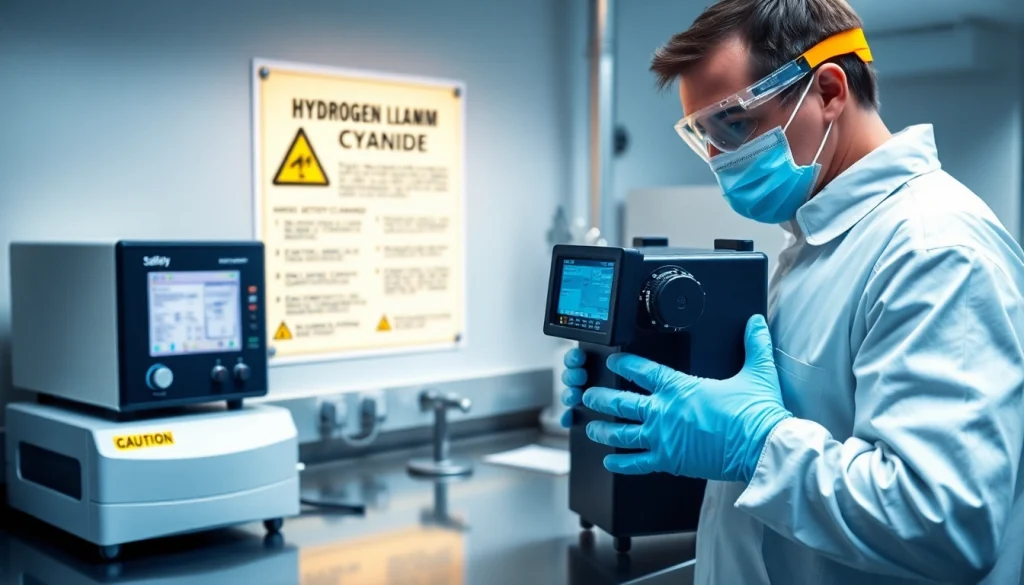Ensuring Safety Through Effective Hydrogen Cyanide Detection Methods

Understanding Hydrogen Cyanide and Its Risks
What is Hydrogen Cyanide?
Hydrogen cyanide (HCN) is a highly toxic chemical compound. It is a colorless, flammable gas or liquid at room temperature, often characterized by its faintly bitter almond odor. HCN is produced both naturally and synthetically; it can be found in small quantities in fruits such as almonds and apricots. However, industrially, it is predominantly generated through various chemical processes, particularly in the manufacture of plastics, synthetic fibers, and pesticides. Due to its versatility in industrial applications, understanding the detection and risks associated with hydrogen cyanide is paramount for safety in workplaces handling this chemical.
Health Risks Associated with Hydrogen Cyanide Exposure
Hydrogen cyanide is incredibly dangerous and poses significant health risks upon exposure, whether inhaled, ingested, or absorbed through the skin. Even at low concentrations, HCN can inhibit cellular respiration by binding to cytochrome c oxidase, an essential enzyme in the electron transport chain. Symptoms of acute exposure include headaches, dizziness, confusion, and respiratory distress. In severe cases, exposure can lead to loss of consciousness and death within minutes. Chronic exposure, even at lower levels, can result in a range of health problems, including neurological impairments and chronic respiratory issues. Therefore, effective Hydrogen Cyanide detection methods must be implemented in environments where HCN is present.
Regulatory Standards for Hydrogen Cyanide Detection
Various regulatory bodies have established strict guidelines to protect workers from the dangers of hydrogen cyanide. The Occupational Safety and Health Administration (OSHA) in the United States sets permissible exposure limits (PEL) allowing for only brief exposure to certain concentrations of HCN. Similarly, the National Institute for Occupational Safety and Health (NIOSH) provides specific recommendations for monitoring and controlling HCN exposure in the workplace. Compliance with these regulations not only ensures the safety of the workforce but also helps prevent legal repercussions for employers. The importance of adhering to these standards cannot be overstated, as they are integral to maintaining a safe working environment.
Methods for Hydrogen Cyanide Detection
Chemical Detection Techniques
Chemical detection techniques for hydrogen cyanide include colorimetric tubes, chemical indicators, and reagent-based methods. Colorimetric detection typically involves the use of specific tubes filled with reagents that change color when exposed to hydrogen cyanide. These tubes can provide quick, on-site analysis, making them valuable for emergency response situations. However, they may not be as accurate for prolonged exposure monitoring.
Electronic Sensing Devices
Modern detection methods have significantly advanced with the development of electronic sensing devices. These include electrochemical sensors, infrared detectors, and photoionization detectors (PIDs), which can continuously monitor air quality. For example, electrochemical sensors can provide real-time data, critical for environments with high risks of HCN exposure. While electronic devices offer more precise measurements and faster alerts, they also require regular maintenance and calibration to ensure accuracy and reliability.
Comparative Analysis of Detection Methods
When comparing chemical detection techniques with electronic sensing devices, several factors come into play. Chemical methods are typically less costly and easier to use in field conditions. However, they may not provide the instant ongoing protection that electronic devices offer. On the other hand, while electronic detectors may have higher upfront costs, their ability to provide continuous monitoring, data logging, and quicker alerts can be invaluable in high-risk environments. Organizations must evaluate their specific needs, considering factors such as potential exposure levels, regulatory compliance, and budget constraints when selecting the appropriate detection method.
Implementing Hydrogen Cyanide Detection Systems
Choosing the Right Detection Equipment
Choosing the right hydrogen cyanide detection equipment is crucial for ensuring workplace safety. Options vary widely, ranging from simple colorimetric tubes to sophisticated multi-gas detectors. Factors to consider include the specific application, potential concentration levels of hydrogen cyanide, and the necessary response time. Employers should also ensure that the equipment complies with local standards and regulations, as well as the conditions of the work environment, like temperature and humidity.
Installation Best Practices
The installation of hydrogen cyanide detection systems should follow industry best practices to maximize effectiveness. This includes selecting optimal locations for sensors, considering airflow patterns, and avoiding obstructions that could hinder detection. Regular training ensuring that staff are familiar with installation procedures and the equipment itself is essential. Additionally, installation should be followed by a thorough testing phase to guarantee that systems are functioning properly and providing accurate readings.
Training Staff for Proper Usage
Training staff on the proper use of hydrogen cyanide detection equipment is vital for maintaining safety. Training programs should encompass the following areas: understanding HCN risks, familiarization with detection methods, emergency response protocols, and equipment maintenance practices. Regular refresher courses can help keep safety at the forefront of the workplace culture, ensuring that employees are equipped to act decisively in the event of a hydrogen cyanide leak.
Maintenance of Detection Systems
Regular Calibration and Testing
Regular calibration and testing of hydrogen cyanide detection systems are necessary to ensure their accuracy and reliability. Calibration should be conducted according to the manufacturer’s specifications, typically involving the use of calibration gases at known concentrations. Testing should also include functional checks to confirm that sensors respond appropriately to changes in HCN levels. Establishing a routine maintenance schedule can prevent equipment failures and ensure consistent protection against exposure.
Identifying Common Issues in Hydrogen Cyanide Detectors
Like any technological system, hydrogen cyanide detectors can encounter issues. Common problems include sensor drift, signal interference, and power source failures. Regular maintenance checks should focus on detecting these issues early, preventing costly delays in safety measures. Training staff to recognize warning signs or symptoms of malfunction can also enhance overall safety and ensure that any potential issues are addressed promptly.
Documentation and Compliance for Maintenance
Documentation is an essential component of maintenance for hydrogen cyanide detection systems. Keeping accurate records of calibration checks, maintenance procedures, and incident reports helps ensure compliance with regulatory standards and provides evidence that safety protocols are being followed. Additionally, documented maintenance can serve as a valuable resource for identifying trends in equipment performance, helping to inform future purchasing and training decisions.
Case Studies on Effective Hydrogen Cyanide Detection
Successful Implementation in Manufacturing
Case studies of successful implementation of hydrogen cyanide detection systems in manufacturing settings illustrate the effectiveness of proactive safety measures. For example, a major plastics manufacturer observed significant reductions in workplace incidents after installing comprehensive electronic detection systems. By integrating real-time monitoring with effective emergency response protocols, the company minimized employee exposure and improved compliance with health regulations.
Emergency Response Scenarios
Emergency response scenarios demonstrate the critical role that hydrogen cyanide detection systems play in ensuring safety. In one incident, a chemical spill led to unexpected HCN release. However, due to advanced detection systems in place, the incident was quickly identified and contained before any employees suffered significant health impacts. Proper training and swift emergency response, supported by reliable detection technology, proved to be key factors in mitigating what could have been a tragic event.
Lessons Learned from Detection Failures
While many organizations successfully implement hydrogen cyanide detection systems, there are also cautionary stories about detection failures. In one case, outdated detection equipment failed to alert staff to high HCN levels, resulting in severe health consequences. This incident underscored the importance of regular maintenance and compliance with industry standards. It serves as a reminder that an effective detection system must be supported by ongoing evaluations, training, and adherence to best practices to ensure worker safety continually.







